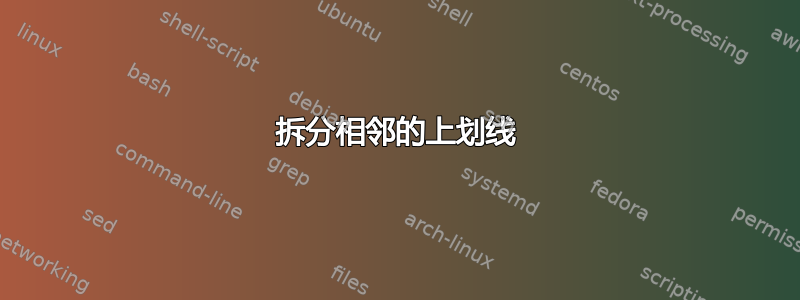
该序列4813065297按降序排列有 5 个相邻对,即81、30、65、52、97。我想通过上划线突出显示这些对,但是65和 重叠52,因此只能得到连续的上划线:
\[4\overline{81}\overline{30}\overline{652}\overline{97}\]
问:6我怎样才能在 到的中间画一条上划线5,然后再从那里到 画另一条线2,并且留出一条可见的小间隙?
答案1
所有的\overlines 都会互相碰撞,因此首先需要一条狭窄的上划线,以留出空隙。
在这里,我创建了\noverline(narrow-overline),它使用字距调整技巧根据输入的长度来缩小上线的\def宽度\nindent。
然后,您需要一些东西来执行问题所要求的操作,创建一个中间留有空隙的上划线。为此,我创建了\midoverline。
\documentclass{article}
\usepackage{mathtools}
\newcommand\nindent{.5pt}
\newcommand\noverline[1]{%
\kern\nindent\overline{\kern-\nindent#1\kern-\nindent}\kern\nindent}
\newcommand\midoverline[1]{%
\sbox0{$#1$}%
\bgroup\ooalign{$#1$\cr$\noverline{\rule{.5\wd0}{0pt}\vphantom{#1}}%
\noverline{\rule{.5\wd0}{0pt}\vphantom{#1}}$}\egroup
}
\begin{document}
\[4\noverline{81}\noverline{30}\midoverline{652}\noverline{97}\]
\end{document}
答案2
您可以减少上划线的长度,并利用所有数字都具有相同的宽度。
\documentclass{article}
\usepackage{amsmath}
\newmuskip\ovskip
\ovskip=1mu
\newcommand{\decr}[1]{%
\mspace{\ovskip}%
\overline{\mspace{-\ovskip}#1\mspace{-\ovskip}}%
\mspace{\ovskip}%
}
\newcommand{\decrdbl}[3]{%
\decr{#1\hspace{0.5\fontcharwd\textfont0`0}}%
\hspace{-0.5\fontcharwd\textfont0`0}%
#2%
\hspace{-0.5\fontcharwd\textfont0`0}%
\decr{\hspace{0.5\fontcharwd\textfont0`0}#3}%
}
\begin{document}
\[
4\decr{81}\decr{30}\decrdbl{6}{5}{2}\decr{97}
\]
\end{document}
你\ovskip=1.5mu会得到
尝试一下最适合您口味的东西。
自动版本
只是为了好玩,这里有一个可以为您完成所有工作的版本。
\documentclass{article}
\usepackage{amsmath}
\newmuskip\ovskip
\ovskip=1mu
\ExplSyntaxOn
\NewDocumentCommand{\markdecrease}{m}
{
\yrodro_markdecrease:n { #1 }
}
\tl_new:N \l__yrodro_markdecrease_tl
\seq_new:N \l__yrodro_markdecrease_seq
\cs_new_protected:Nn \yrodro_markdecrease:n
{
% typeset the number
#1
% back up
\hspace{-\tl_count:n { #1 } \fontcharwd\textfont0`0}
% compute the overlines
\tl_clear:N \l__yrodro_markdecrease_tl
\__yrodro_markdecrease:NN #1 \q_nil
}
\cs_new_protected:Nn \__yrodro_markdecrease:NN
{
\quark_if_nil:NTF { #2 }
{% end of the recursion, add the last digit
\tl_put_right:Nn \l__yrodro_markdecrease_tl { #1 }
% split at periods
\seq_set_split:NnV \l__yrodro_markdecrease_seq { . } \l__yrodro_markdecrease_tl
% produce the overlines
\seq_map_function:NN \l__yrodro_markdecrease_seq \__yrodro_markdecrease_item:n
}
{% there are more digits, add the first one
\tl_put_right:Nn \l__yrodro_markdecrease_tl { #1 }
% if the next digit is not less than the current one, add a period
\int_compare:nF { #1 > #2 }
{
\tl_put_right:Nn \l__yrodro_markdecrease_tl { . }
}
% restart the recursion with the next digit as the first one
\__yrodro_markdecrease:NN #2
}
}
\cs_new_protected:Nn \__yrodro_markdecrease_item:n
{
\int_case:nnF { \tl_count:n { #1 } }
{
{1}{ \__yrodro_markdecrease_blank: }
{2}{ \__yrodro_markdecrease_over:n {00} }
}
{ \__yrodro_markdecrease_more:n { #1 } }
}
\cs_new_protected:Nn \__yrodro_markdecrease_blank:
{
\phantom{0}
}
\cs_new_protected:Nn \__yrodro_markdecrease_over:n
{
\mspace{\ovskip}
\overline{\mspace{-\ovskip}\phantom{#1}\mspace{-\ovskip}}
\mspace{\ovskip}
}
\cs_new_protected:Nn \__yrodro_markdecrease_more:n
{
\__yrodro_markdecrease_oneandhalf:
\prg_replicate:nn { \tl_count:n { #1 } - 3 } { \__yrodro_markdecrease_over:n {0} }
\__yrodro_markdecrease_oneandhalf:
}
\cs_new_protected:Nn \__yrodro_markdecrease_oneandhalf:
{
\mspace{\ovskip}
\overline{\mspace{-\ovskip}\phantom{0}\hspace{0.5\fontcharwd\textfont0`0}\mspace{-\ovskip}}
\mspace{\ovskip}
}
\ExplSyntaxOff
\begin{document}
\[
\markdecrease{4813065297}\quad\markdecrease{9876543210}
\]
\end{document}
略有不同的版本,它绘制从数字中间开始并结束的上线(带有小间隙)。
\documentclass{article}
\usepackage{amsmath}
\newmuskip\ovskip
\ovskip=1mu
\ExplSyntaxOn
\NewDocumentCommand{\markdecrease}{m}
{
\yrodro_markdecrease:n { #1 }
}
\tl_new:N \l__yrodro_markdecrease_tl
\seq_new:N \l__yrodro_markdecrease_seq
\cs_new_protected:Nn \yrodro_markdecrease:n
{
% typeset the number
#1
% back up
\hspace{-\tl_count:n { #1 } \fontcharwd\textfont0`0}
% compute the overlines
\tl_clear:N \l__yrodro_markdecrease_tl
\__yrodro_markdecrease:NN #1 \q_nil
}
\cs_new_protected:Nn \__yrodro_markdecrease:NN
{
\quark_if_nil:NTF { #2 }
{% end of the recursion, add the last digit
\tl_put_right:Nn \l__yrodro_markdecrease_tl { #1 }
% split at periods
\seq_set_split:NnV \l__yrodro_markdecrease_seq { . } \l__yrodro_markdecrease_tl
% produce the overlines
\seq_map_function:NN \l__yrodro_markdecrease_seq \__yrodro_markdecrease_item:n
}
{% there are more digits, add the first one
\tl_put_right:Nn \l__yrodro_markdecrease_tl { #1 }
% if the next digit is not less than the current one, add a period
\int_compare:nF { #1 > #2 }
{
\tl_put_right:Nn \l__yrodro_markdecrease_tl { . }
}
% restart the recursion with the next digit as the first one
\__yrodro_markdecrease:NN #2
}
}
\cs_new_protected:Nn \__yrodro_markdecrease_item:n
{
\hspace{0.5\fontcharwd\textfont0`0}
\prg_replicate:nn { \tl_count:n { #1 } - 1 }
{
\mspace{\ovskip}
\overline{\mspace{-\ovskip}\phantom{0}\mspace{-\ovskip}}
\mspace{\ovskip}
}
\hspace{0.5\fontcharwd\textfont0`0}
}
\ExplSyntaxOff
\begin{document}
\[
\markdecrease{4813065297}\quad\markdecrease{9876543210}
\]
\end{document}







